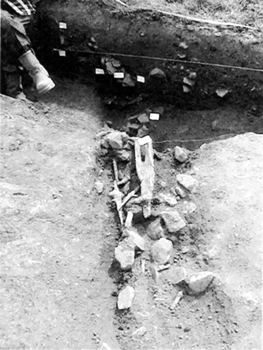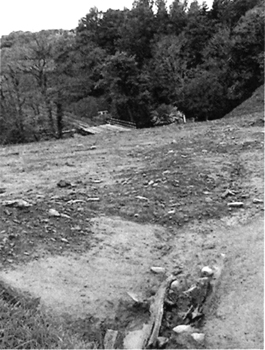Every day the societies office receives questions from the public on hedges and Hedge Laying. Recently we had a question that got us thinking:
“I'm an archaeologist working on a dig in South Wales, not far from Carmarthen. We recently exposed a number of branches arranged
in a line, on top of stones placed in a long, shallow gully. At first we presumed the branches must have been hollowed out for use as a land-drain,
but upon finding this not to be the case, the current theory is that they represent a failed living field boundary. i.e. An attempt was made to ‘place’
a hedge in the laid style, but the hedge died, leaving a straight line of branches.

I was hoping you would be able to confirm our interpretation by answering a couple of questions concerning the basics of laying.
- Is it possible to move a hedge, almost like planting cuttings, by bringing in a live branch, placing it in a linear cut, and expecting it to root and shoot?
- If so, would you fill this linear cut with cobbles to assist with drainage?
I appreciate immensely your thoughts if you can spare some time to ponder these questions. If you believe this to be the right interpretation
and would like to publish an article on your website regarding the find, I would be happy to provide photographs. (Although, for the record,
from the state of the wood, it is unlikely the find is any older than a hundred years).
Kind regards, Owen Raybould”
Well we discussed the possibilities with a few members, further questioning determined that the find was most probably less than 100 years old;
the wood is 10/15cms diameter and 3 to 4m long. The find did not appear to be associated with any other structure.

It was not possible to arrive at a definitive answer but after much thought we were able to come up with some ideas:
A Drainage Channel - But why would branches be placed over the top?
A Dead Hedge - But there was no sign of any stakes and the branches did not appear to have been cut.
Erosion Hedge - To prevent erosion of the hillside by providing a soak away and perhaps preventing sheep from overgrazing the area.
We think that the Erosion Hedge is the most plausible suggestion as this is a technique that is known to have been used within living memory.
Sheep seek shelter on the lea side of a steep hill and their constant rubbing creates holes where water seeps in and causes erosion.
To prevent this, tree branches were placed over the area and anchored down so that the sheep could not erode the hill further.
In places where erosion was very bad, erosion channels were dug to drain away run off water.
Of course we are still open to suggestions so if you have any other ideas please let us know.